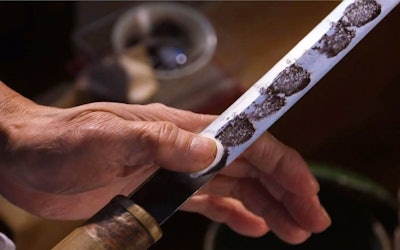Sword Polishing Is a Highly Difficult Type of Craftsmanship for Maintaining Japanese Swords. A Look at the Uncompromising Techniques That Go Into Restoring Japan's Historical Swords
Traditional Crafts
A Look at the Polishing Techniques Used for Japanese Swords
This video, titled "日本刀の研磨 手入れ 本阿弥流 Polishing katana Japanese sword," was released by " JAPAN STUDY 日本研究."
Craftsmen who polish swords for a living are called "togishi" (研師) in Japanese.
Among these craftsmen, the Hon'ami school shown in the video is a professional sword polishing school that has been around since the Nanboku-cho Period (1336-1392 A.D.).
At 12:21 in the video, a stunning view of "Kanamori Masamune," a famous dagger, is introduced.
The History and Techniques of Japanese Sword Polishing
Source :YouTube screenshot
Sword polishing has a long history in Japan and was already being practiced when chokuto (直刀, Japanese straight swords) were still being used.
The Hon'ami family, who served Ashikaga Takauji during the Nanboku-cho Period, later established sword polishing and sword appraisal methods.
When a sharpener receives a request for sword polishing, he first observes the sword for about a week to visualize the precise polishing.
The sword polishing process incorporates a unique technical system.
When polishing a sword, it is polished under the assumption that it will be used to cut down enemies, but it is also important to sharpen it in a way that brings out the beauty of the sword, so that the base metal and the hamon (刃文, blade pattern) can be seen clearly.
The Sword Polishing Techniques in the Video
Source :YouTube screenshot
The person introduced at 1:00 in the video is Koshu Hon'ami, a living national treasure of the Hon'ami family.
He uses whetstones to carefully polish Japanese swords.
There are several types of sword polishers, including Binsuido, Kaiseido, Nagurado, Koma-Nagurado, Uchigumorihado, and Uchigumorijido.
The sword is finely polished after being given a rough polish, and then adjusted through finishing polishes.
A whetstone called "Narutaki" (鳴滝) is used to polish the surface of the blade, and various secret techniques are used when polishing the swords.
There are many different polishes performed when polishing Japanese swords and many of these can be seen in the video.
Sharpening the tip of the sword is called “narume” (ナルメ).
It's important to finish the narume polishing carefully while protecting the blade of the sword.
Summary of Japan’s Sword Polishing Techniques
Source :YouTube screenshot
Today, there are approximately 50 sword polishing professionals in Japan.
There is no set qualification system for sword polishing, but in order to become a swordsmith or a sharpener, one must work under a master or attend a class to acquire advanced skills.
Many people around the world are fascinated by Japan's unique swords.
In order to maintain the brilliance of the swords, the skills of the sword polishers shown in this video are essential.
 Video article 13:11
Video article 13:11 Video article 10:00
Video article 10:00